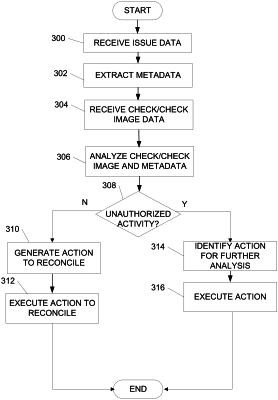| CPC G06Q 20/0425 (2013.01) [G06N 20/00 (2019.01); G06Q 20/4016 (2013.01); G06V 30/2253 (2022.01)] | 15 Claims |

|
6. A method, comprising:
receiving, by a computing platform having at least one processor and a memory and from a customer computing system, historical check data associated with authorized and unauthorized checks;
training, by the at least one processor and using the historical check data, a machine learning model to identify patterns or sequences in data associated with one or more checks to determine whether a check of the one or more checks should be approved or rejected;
generating, by the at least one processor and from the historical check data, one or more common issue rules, wherein the one or more common issue rules include a rule identifying an image flaw generated by an image capture device at a particular automated teller machine (ATM), wherein the image flaw includes a stray mark caused by the image capture device at the particular ATM;
receiving, by the at least one processor and from the customer computing system, issue data associated with a plurality of checks issued by a customer;
extracting, by the at least one processor and from the issue data, metadata associated with each check of the plurality of checks;
receiving, by the at least one processor, one or more checks for reconciliation;
scanning, by the at least one processor, the one or more checks for reconciliation to generate scanned images of the one or more checks for reconciliation;
extracting, by the at least one processor and from the images of the one or more checks for reconciliation and using optical character recognition, data from the one or more checks for reconciliation;
analyzing, by the at least one processor, the data from the images of the one or more checks for reconciliation and the metadata associated with the each check of the plurality of checks to determine whether to approve or reject each check of the received one or more checks for reconciliation, wherein the analyzing includes:
applying the one or more common issue rules; and
executing, by the at least one processor, the machine learning model, to compare, using one or more machine learning datasets, the data from the images of the one or more checks for reconciliation to the metadata associated with the each check of the plurality of checks to determine whether to approve or reject the each check of the received one or more checks for reconciliation;
responsive to determining to approve a first check of the received one or more checks for reconciliation, identifying, by the at least one processor, a first action to execute;
responsive to determining to reject the first check of the received one or more checks for reconciliation, identifying, by the at least one processor, a second, different action to execute;
executing, by the at least one processor, one of the first action or the second action; and
updating, by the at least one processor, the machine learning model based on the determination of whether to approve or reject the each check of the received one or more checks for reconciliation.
|